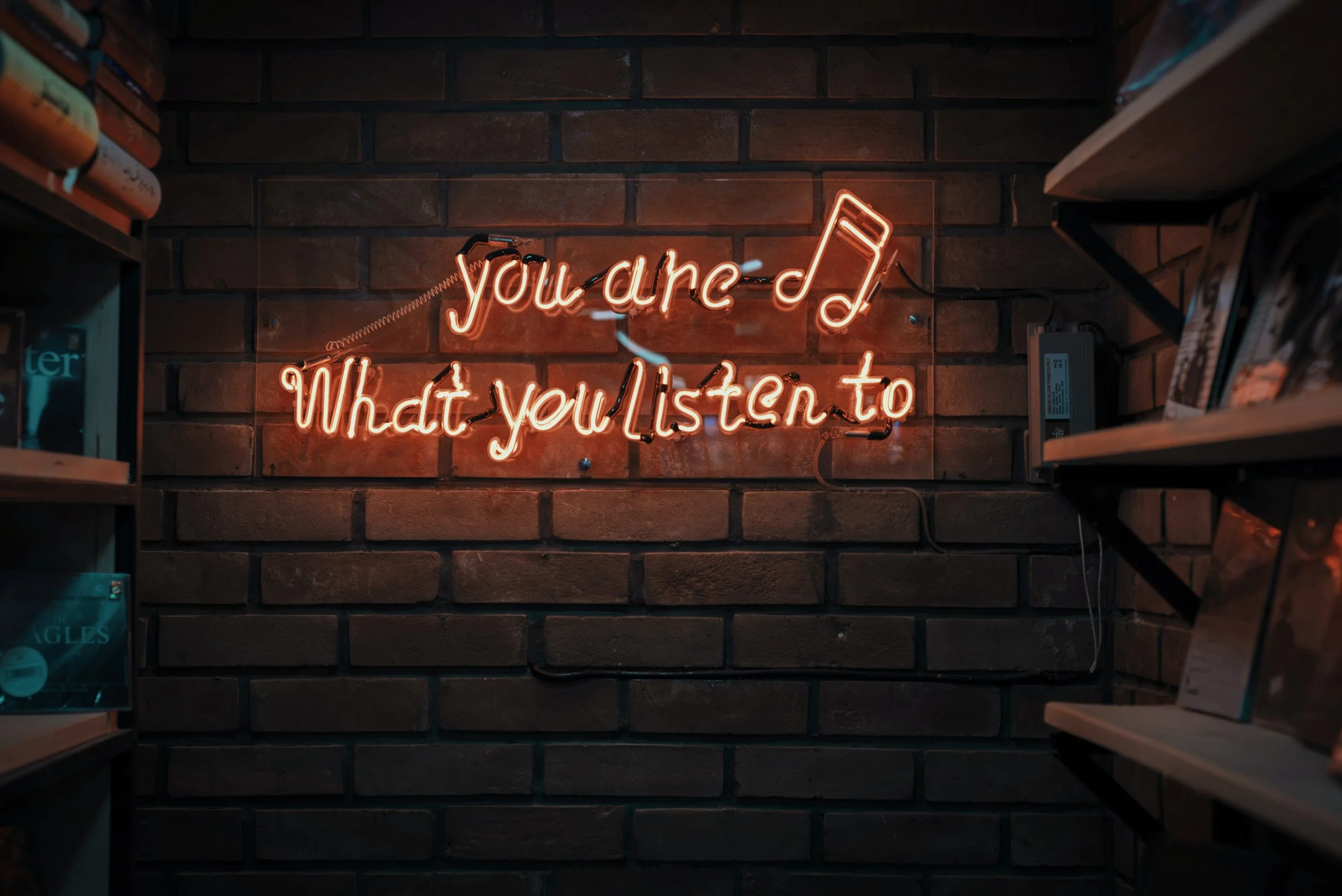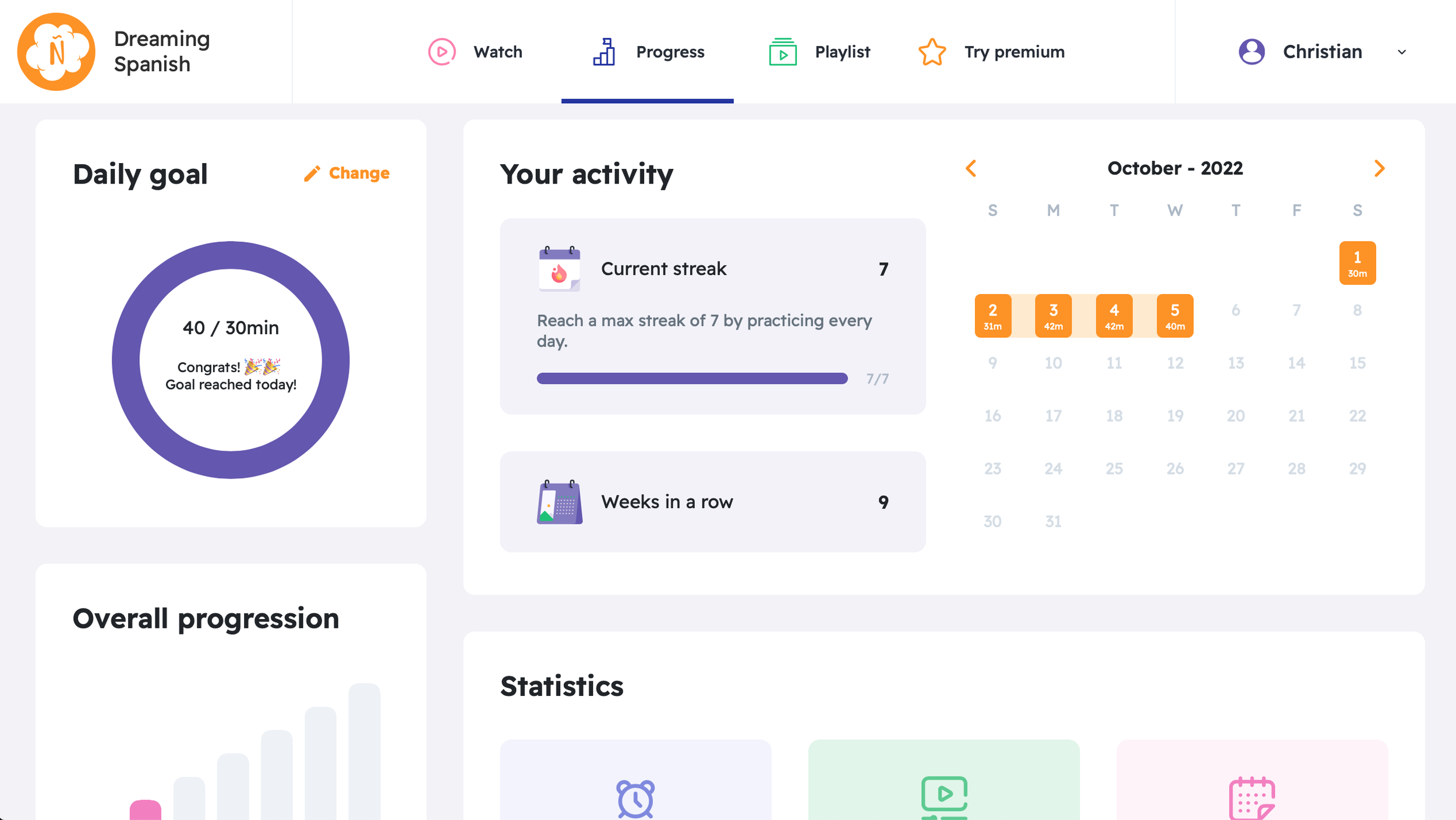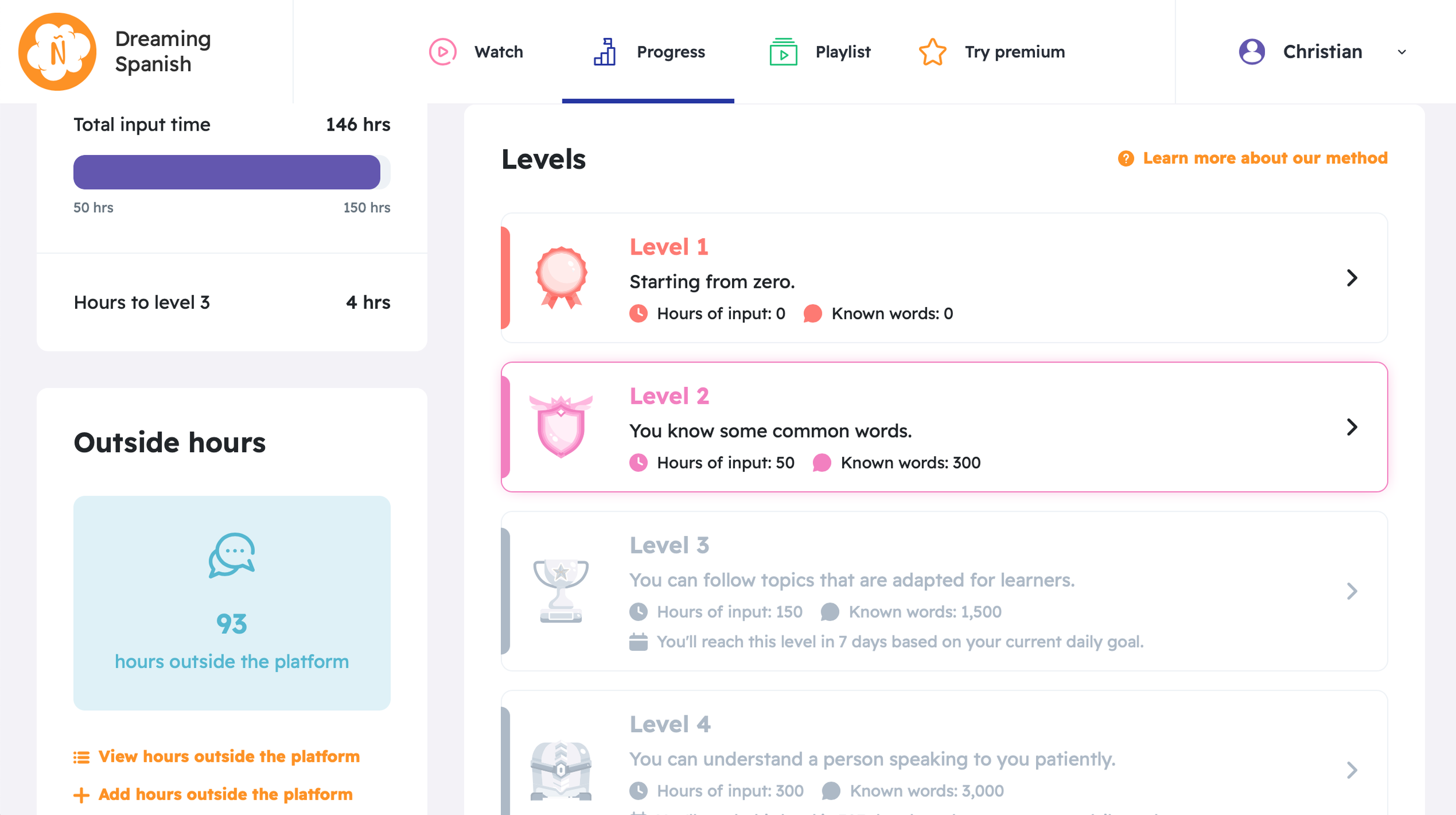The Blueprint to Spanish Fluency (Part 2) - Listening
*This blog is reader-supported. I may earn a commission for purchases made through links in this post. Read full Affiliate Disclaimer here.
Contents
How to listen for best results
How much listening should you do each day?
Learning with videos perfect for your level
Saving time with playlists
Audiobooks
The 1-2 punch of listening & reading
In my last blog post The Blueprint to Spanish Fluency (Part 1) - Reading Books we talked about how you can use reading in a way that’s not only super effective, but also highly enjoyable in order to learn Spanish.
In this part 2 we will talk about what is actually THE most important skill to develop when learning a language.
If you had to only pick one thing it would without a doubt be this one skill.
Listening.
”Wait just a minute?! I thought you said reading was the most effective way to expand your vocabulary? Shouldn’t that be number 1?”
As much as I love and believe in reading, listening is actually more important.
Reading is the fastest way to learn a lot of words, but it’s by listening that we start to internalize the language and make it part of us.
Listening is what will eventually translate into us being able to what most of us want to do.
Speak it.
Because the way to get good at speaking is by hearing and absorbing the way others speak. To the point where you have an intuitive feel for the language and it just feels natural to you.
Through this process you begin to hear certain words, sentences and expressions in your head. A bit like getting a certain song stuck on your mind.
Once you’re able to hear it in your head, the step to speak is actually not that difficult.
When I coach people in learning languages they are surprised to be able to respond much easier to other people, without even having practiced any speaking. It’s the result of one thing.
Input through listening.
So what should you listen to? And what is the best way to do it to see the fastest progress in your Spanish?
In this blog post I’m going to share with you how and what to listen to.
I will also share what I have personally been and currently am doing, so that you can get some great resources and ideas for how you can improve your own listening ability.
There are lots of Spanish resources out there, but this will give you a good place to start.
How to listen for best results
If Spanish is your first foreign language you will probably have the temptation to want to understand everything you’re hearing.
This was a big struggle for me when I first started learning Cantonese and it hindered my progress a lot.
Reading is easier than listening because it’s more concrete. Listening is more abstract.
With reading you can take your time to understand at your own pace and it’s right there in front of you on paper. With listening there is also the added challenge of the difference in pronunciation of spoken language. And also the slurring of words and the speed of the speaker, which is beyond your control.
And with Spanish, people speak very fast.
Plus, not always very clear.
Because of the ambiguous nature of listening you’re simply not going to pick up every word that you hear. This is completely normal and something to just get used to (check out my post Why Subtitles are Hurting Your Language Learning to learn more about tolerating ambiguity). Because even if you feel like you’re not understanding much you are still learning, I promise you that.
It just takes faith.
It takes faith in the process and that by continuing to listen you will understand more and more. That your brain is capable of making sense of it by just giving it enough time with the language. That what was blurry will eventually become clear.
It really is something that starts to pay off after weeks and months of doing it consistently every day.
What I suggest doing is just to try to understand.
Not by putting in a lot of effort into it, but in a very relaxed way.
Try to pay attention, but don’t worry if you start thinking about something else as you listen. This happens to all of us.
Your brain is still picking up on sounds and patterns in the language even if you’re not 100% focused. So don’t beat yourself up if when your mind wanders. Just gently bring your focus back to what you’re listening to.
Do your best. That’s enough.
Some days you’re going to have an easy time focusing, and some days it’s going to be more difficult. This can be influenced by so many things such as having a lot of things on your mind, getting a bad night’s sleep, and so on.
Just keep putting in the time anyways and you’ll see results guaranteed.
Think of it as more of quantity over quality.
If you’re having a really hard time paying attention then it might just be that you’re not interested in what you’re listening to and you just need to simply switch to something else. Because when the content is truly interesting to you - you won’t have to force yourself to pay attention.
But more on that in a future post.
How much listening should you do each day?
At the end of the day learning a language is about volume - the amount of time spent with the language.
The sheer volume of how much you listen over the weeks and months is really what is going to bring you the results you want.
How much time should you listen every day?
This will be different from person to person. The important thing is just that it’s a doable goal that you can accomplish every day.
It’s very helpful to have a specific time goal to reach for on a daily basis when practicing listening. It’s a much more abstract skill than reading so it can difficult to gauge how much you’re actually progressing.
Being able to understand takes time and consistency to develop.
It’s a slow burn kind of a thing.
Sometimes you might not notice improvement for several weeks, even though you are, in fact, improving.
How much time you choose to spend listening each day is going to depend on two things:
1.) How fast you want to progress
2.) What will to be doable and not overwhelming for you
For me I find that 30 mins each day is a perfect goal for me.
If I wasn’t learning other languages I would listen a lot more. But I have zero rush improving my Spanish (which is actually a huge advantage, since it takes the pressure off). I’m very happy with my progress so far and how things are going.
If I felt I wasn’t improving as fast as I wanted to then I would just increase the time I spent listening.
If you really wanna improve quickly I would suggest listening to one hour or even more.
The more you listen the faster you will progress.
This also boosts motivation. Spending more time makes you wanna spend even more time with the language, interestingly enough. What we focus on grows.
You just have to weigh the speed you want to go at vs. something you can actually stick to every single day (even the days when you feel off). So that it’s not overwhelming and rather something you look forward to every day.
Language learning should be fun and enjoyable!
Over time you will find that it’s easier to extend how much you listen and you’re likely to want to listen more just out of enjoyment.
It’s something that becomes more and more fun the better we get at it.
A good idea is to start small and build up from there. You might wanna start with just 10 mins to just get into the habit of listening. It’s much easier to add more time once it has become a habit for you to listen to Spanish every day.
“At the end of the day learning a language is about volume - the amount of time spent with the language.”
Learning with videos perfect for your level
Watching videos that are targeted to your current level is a great way to build up your listening abilities.
My favorite website for doing that is Dreaming Spanish.
It’s an awesome and completely free learning resource by Pablo Róman from Spain.
I started watching the YouTube videos already when we were in Spain about a month or so into learning Spanish (this was when I was still doing Pimsleur). I found myself really enjoying the content and it was much easier to understand than many other resources out there.
The whole idea behind Dreaming Spanish is to not study grammar or learn any rules (which I firmly believe in), but to find easy videos that is at your current level.
It’s basically tons and tons of videos about different topics and every video indicates the level it’s at.
There are 4 levels: super beginner, beginner, intermediate and advanced. For the super beginner & beginner videos they speak very clear, much slower and utilize drawings to make everything more comprehensible. You’re immersing yourself in Spanish and improving your listening, without the use of subtitles, and at a level that’s very comfortable for you.
Learning purely by watching and listening.
Since I’ve been learning two very challenging languages (Cantonese & Finnish) that have very few resources, it feels like such a luxury to have access to something like Dreaming Spanish!
There are videos coming out every day so you won’t be running out of things to watch any time soon. You can also filter the videos by topic, Spanish dialect, level, and so on, which makes it easy to find content that fits you.
Dreaming Spanish also has a YouTube channel that has the same content as the website (you can also sign up for a premium membership there and get access to even more videos for a low price of $8/month)
BUT.
I do recommend using the website since it has three, in my opinion, major advantages.
1.) You can easily see what videos you’ve already watched before, and also add any videos you’d want to watch in the future to a playlist. It’s a big time-saver.
2.) You can set a watching goal for: 15, 30 or 60 mins or a custom goal, that you want to hit every day. You then have a clear visual for when you’ve hit that goal, which is very satisfying and motivating.
3.) It keeps track of overall watch time. This gives you a picture of your overall goal and can keep your expectations realistic. You can even add what you’ve watched on other platforms outside Dreaming Spanish to this list, which is great!
The content is varied enough where it keeps it interesting enough to come back day after day. There’s a lot of humor in the content as well so it has quite a “light” atmosphere, which I enjoy.
(For more about Dreaming Spanish check out my post Everything You Need to Know about Dreaming Spanish)
Another good YouTube channel to use for simple Spanish is: Spanish Playground.
There are many Spanish channels out there that you can choose from. The important thing is just that it’s purely in Spanish with NO English. '
Some platforms have podcasts that are half English and half Spanish. I would stay clear of those since that’s just a big waste of time. It will literally double the amount of time it takes for you to learn, since you need to actually listen to the language you’re learning to learn to understand it.
Listening to English is not going to help you in your Spanish.
Saving time with playlists
In order to get listening in it needs to be easy to do.
Having audio that’s just sitting and ready to go will greatly increase how often you open your phone or your computer to get your listening in.
Dreaming Spanish and its playlist is great as you can add videos as you find them. So that when you do have those 15 or 30 mins to listen you don’t have to waste time searching what to watch.
Having audio ready and available to be played on-the-go is a great convenience and time-saver.
Keep the barrier of entry to getting start each day as low as possible.
It will ensure that you actually do it and get in the volume necessary to see tangible process.
With LingQ (sign up through this link to get the best discount that I’ve found) you can find all sorts of podcasts on different topics. I’ve been listening to several of those and I also went through the Olly Richard’s Spanish short stories both by reading and listening to them.
LingQ has tons of content for Spanish.
Tons.
It’s a big library and you can also important whatever you want.
What you choose to listen to doesn’t matter. Just pick something that peaks your curiosity and interest.
LingQ lets you easily add and organize these into different playlists, which makes things very convenient.
Rather than having to switch tracks and look for what to listen to next you just press play on the playlist. Then you can walk to the gym, drive to work, do housework, or whatever you’d like to while listening.
It takes a little bit of preparation outside of the time you spend listening, but it’s so worth it.
Audiobooks
A year or so ago I read the book Atomic Habits by James Clear in Finnish.
I imported it to LingQ and read it there like I always do with Finnish and the languages I’m learning.
It was a very impactful book for me about the power of our habits and how to easily create those to improve different areas and skills in our lives. So I wanted to go through it again and learn even more from the content.
I considered listening to it in English, but since I’m always looking for ways to improve in the languages I’m learning (by doing what I’m going to do anyway) I looked for it in Spanish.
Sure enough, the Spanish version of Atomic Habits was available on Audible (← try a Free 30-day trial).
I wasn’t fully sure if it was going to be a good resource for me at this point though. Because I still have trouble understanding full-speed native speech.
But I decided to give it a shot and surprisingly I could actually understand most of it!
The reason was because I was already familiar with the content, the stories and the topic. So the words that I didn’t know was much easier to guess just out of context and familiarity with the topic of the book.
Audiobooks are great since the audio is clear, they speak with clear pronunciation, and they also speak slower than what you would normally hear from natives in a typical every day conversation.
I would advice doing at least 100-150 hours or so of listening before you attempt to use an audiobook (I’m currently at 150 hours). At that point I would pick something you’re already familiar with to start with.
Later on you can listen to more complex content once you have built up more ability in the language.
The level of difficulty is of course gonna depend on the book, but once you’re ready it’s a great language learning resource.
The only minus is that you won’t get actual spoken language, but written language that is being spoken.
However.
As long as you’re listening to podcasts, videos and other materials where people speak in a more every-day spoken way, this is not going to be a problem.
The 1-2 punch of listening & reading
Listening & reading is the 1-2-punch that will let you learn a language in the most efficient way.
You could, of course, do only listening.
But if you want to improve fast, I suggest combining listening with reading.
You expand your vocabulary quickly by reading, which will make it much easier for you pick up on these words when listening. So you’re basically expanding your internal storage space of words by reading, and then when listening you internalize them. Matt from Matt vs Japan said it well:
“You're pushing your cutting edge of vocabulary and grammar knowledge forward through reading, and the when you're listening you're pretty much just playing catch-up.”
Listening will ultimately translate into speaking, giving you better pronunciation and a more natural intuitive feel of how people speak.
This will then become more and more the way you speak, making you sound more and more like a native.
If you’d like more language learning tips then download my Free Guide
Intuitive Language Secrets:
In the next post we will go over what I believe is what will either make or break your success when learning a language.
Without it most people have a hard time practically implementing these two activities of reading and listening.
See you in the next post!






